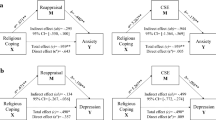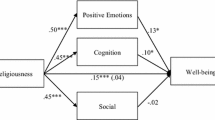Abstract
People who are more religious tend to experience more positive affect and higher levels of life satisfaction. Current explanations for this relation include social support, meaning in life, and more positive emotional experiences. Adding cognitive reappraisal as a new mechanism, we propose that religion consistently trains people to reappraise emotional events, making the devout more effective in applying this emotion regulation practice, which cultivates more positive affect and greater life satisfaction. In two studies, involving Israeli Jewish (N = 288) and American Christian (N = 277) participants, we found that more frequent use of cognitive reappraisal mediated the relationship between religiosity and affective experiences, which in turn, were associated with greater life satisfaction. Religiosity was associated with more frequent cognitive reappraisal (in both samples) and less frequent expressive suppression (in the Christian sample). Cognitive reappraisal mediated the link between religiosity and positive affect (in both samples) as well as negative affect (in the Christian sample). We discuss implications for understanding the link between religion and emotional well-being.



Similar content being viewed by others
Notes
The sample is identical to the Jewish sample which appears in Vishkin et al. (2016, Study 1). The original sample size was 313, but 4% were excluded from the analyses because they were not Jewish, and 4% were excluded for providing the same response 90% of the time or more (see Schwartz and Rubel-Lifschitz 2009). The measures were collected as part of a larger survey that addressed additional unrelated questions. The sample size was determined based on the other research questions that were tested.
The item assessing social identity was not included in Vishkin et al. (2016), but was included here because belonging to a religious community has been linked to well-being (e.g., Lim and Putnam 2010). When the analyses reported in Vishkin et al. (2016) were conducted with this additional item included in the religiosity measure, results remained unchanged. We now report all the items used to measure religiosity.
We analyzed the models both by averaging across all religiosity items (α = .88) and by averaging across each scale. Results were equivalent.
Some of the data collected in this study are also reported in Vishkin et al. (2016), Study 1.
An insignificant Chi square test indicates that the model is acceptable; that is, the observed covariance matrix is similar to the predicted covariance matrix.
Factor loadings and the complete correlation matrix for all items are available from the authors.
The sample is identical to the Christian sample which appears in Vishkin et al. (2016, Study 1). The original sample size was 368, 22% were excluded from the analyses for identifying with a religion other than Christianity and 3% were excluded based on the exclusion criteria used in Study 1. The sample size was set to be similar to that of Study 1.
We analyzed the models both by averaging across all religiosity items (α = .89) and by averaging across each scale. Results were equivalent.
Some of the data collected in this study are also reported in Vishkin et al. (2016), Study 1.
All data relevant to religiosity and well-being has been reported.
References
Aldao, A., Nolen-Hoeksema, S., & Schweizer, S. (2010). Emotion-regulation strategies across psychopathology: A meta-analytic review. Clinical Psychology Review, 30, 217–237.
Augustine, A. A., Hemenover, S. H., Larsen, R. J., & Shulman, T. E. (2010). Composition and consistency of the desired affective state: The role of personality and motivation. Motivation and Emotion, 34, 133–143.
Baumeister, R. F. (1991). Meanings of life. New York, NY: Guilford Press.
Ben-Nun Bloom, P., Arikan, G., & Courtemanche, M. (2015). Religious social identity, religious belief, and anti-immigration sentiment. American Political Science Review, 109, 203–221.
Buhrmester, M., Kwang, T., & Gosling, S. D. (2011). Amazon’s mechanical turk: A new source of inexpensive, yet high-quality, data? Perspectives on Psychological Science, 6, 3–5.
Cohen, A. B. (2009). Many forms of culture. American Psychologist, 64, 194–204.
Compton, W. C., Smith, M. L., Cornish, K. A., & Qualls, D. L. (1996). Factor structure of mental health measures. Journal of Personality and Social Psychology, 71, 406–413.
Davies, D. J. (2011). Emotion, identity and religion: Hope, reciprocity, and otherness. Oxford, UK: Oxford University Press.
Diener, E., & Clifton, D. (2002). Life satisfaction and religiosity in broad probability samples. Psychological Inquiry, 13, 206–209.
Diener, E., Emmons, R. A., Larsen, R. J., & Griffin, S. (1985). The satisfaction with life scale. Journal of Personality Assessment, 49, 71–75.
Diener, E., Suh, E., Lucas, R. E., & Smith, H. L. (1999). Subjective well-being: Three decades of progress. Psychological Bulletin, 125, 276–302.
Diener, E., Tay, L., & Myers, D. G. (2011). The religion paradox: If religion makes people happy, why are so many dropping out? Journal of Personality and Social Psychology, 101, 1278–1290.
Diener, E., Wirtz, D., Tov, W., Kim-Prieto, C., Choi, D., Oishi, S., et al. (2010). New well-being measures: Short scales to assess flourishing and positive and negative feelings. Social Indicators Research, 97, 143–156.
Durkheim, E. (1915/1965). The elementary forms of religious life (J. W. Swain, Trans.). New York, NY: The Free Press.
Ellison, C. G., & Levin, J. S. (1998). The Religion-health connection: Evidence, theory, and future directions. Health Education and Behavior, 25, 700–720.
Emmons, R. A., & Crumpler, C. A. (2000). Gratitude as a human strength: Appraising the evidence. Journal of Social and Clinical Psychology, 19, 56–69.
Fredrickson, B. L. (2002). How does religion benefit health and well-being? Are positive emotions active ingredients? Psychological Inquiry, 13, 209–213.
Gebauer, J. E., Sedikides, C., & Neberich, W. (2012). Religiosity, social self-esteem, and psychological adjustment: On the cross-cultural specificity of the psychological benefits of religiosity. Psychological Science, 23, 158–160.
George, L. K., Ellison, C. G., & Larson, D. B. (2002). Explaining the relationships between religious involvement and health. Psychological Inquiry, 13, 190–200.
Graham, J., & Haidt, J. (2010). Beyond beliefs: Religions bind individuals into moral communities. Personality and Social Psychology Review, 14, 140–150.
Gross, J. J. (1998). Antecedent and response focused emotion regulation: Divergent consequences for experience, expression and physiology. Journal of Personality and Social Psychology, 74, 224–237.
Gross, J. J., & John, O. P. (2003). Individual differences in two emotion regulation processes: Implications for affect, relationships, and well-being. Journal of Personality and Social Psychology, 85, 348–362.
Gross, J. J., & Levenson, R. W. (1993). Emotional suppression: Physiology, self-report, and expressive behavior. Journal of Personality and Social Psychology, 64, 970–986.
Gross, J. J., & Levenson, R. W. (1997). Hiding feelings: The acute effects of inhibiting negative and positive emotion. Journal of Abnormal Psychology, 106, 95–103.
Gross, J. J., Richards, J. M., & John, O. P. (2006). Emotion regulation in everyday life. In D. K. Snyder, J. A. Simpson, & J. N. Hughes (Eds.), Emotion regulation in families: Pathways to dysfunction and health (pp. 13–35). Washington, DC: American Psychological Association.
Hackney, C. H., & Sanders, G. S. (2003). Religiosity and mental health: A meta-analysis of recent studies. Journal for the Scientific Study of Religion, 42, 43–55.
Hall, M. E. L., & Johnson, E. L. (2001). Theodicy and therapy: Philosophical/theological contributions to the problem of suffering. Journal of Psychology and Christianity, 20, 5–17.
Hill, P. C., & Pargament, K. I. (2003). Advances in the conceptualization and measurement of religion and spirituality. American Psychologist, 58, 64–74.
Hu, L., & Bentler, P. M. (1999). Cutoff criteria for fit indexes in covariance structure analysis: Conventional criteria versus new alternatives. Structural Equation Modeling, 6, 1–55.
Kämpfe, N., & Mitte, K. (2009). What you wish is what you get? The meaning of individual variability in desired affect and affective discrepancy. Journal of Research in Personality, 43, 409–418.
Kim-Prieto, C., & Diener, E. (2009). Religion as a source of variation in the experience of positive and negative emotions. The Journal of Positive Psychology, 4, 447–460.
Kline, R. B. (2005). Principles and practice of structural equation modeling (2nd ed.). New York: The Guilford Press.
Koenig, H. G. (2012). Religion, spirituality, and health: The research and clinical implications. ISRN Psychiatry, 2012, 1–33.
Koenig, H. G., McCullough, M. E., & Larson, D. B. (2001). Handbook of religion and health. New York: Oxford University Press.
Kortt, M. A., Dollery, B., & Grant, B. (2014). Religion and life satisfaction down under. Journal of Happiness Studies, 16, 277–293.
Krause, N. (2003). Religious meaning and subjective well-being in late life. Journal of Gerontology: Social Sciences, 58B, S160–S170.
Kuppens, P., Realo, A., & Diener, E. (2008). The role of positive and negative emotions in life satisfaction judgment across nations. Journal of Personality and Social Psychology, 95, 66–75.
Lambert, N. M., Fincham, F. D., Braithwaite, S. R., Graham, S. M., & Beach, S. R. H. (2009). Can prayer increase gratitude? Psychology of Religion and Spirituality, 1, 139–149.
Laurin, K., Kay, A. C., & Fitzsimons, G. M. (2012). Divergent effects of activating thoughts of God on self-regulation. Journal of Personality and Social Psychology, 102, 4–21.
Lim, C., & Putnam, R. D. (2010). Religion, social networks, and life satisfaction. American Sociological Review, 75, 914–933.
Lucas, R. E., Diener, E., & Suh, E. (1996). Discriminant validity of well-being measures. Journal of Personality and Social Psychology, 71, 616–628.
Mauss, I. B., & Tamir, M. (2014). Emotion goals: How their content, structure, and operation shape emotion regulation. In J. J. Gross (Ed.), The handbook of emotion regulation (2nd ed., pp. 361–375). New York, NY: Guilford Press.
May, M., & Smilde, D. (2016). Minority participation and well-being in majority catholic nations: What does it mean to be a religious minority? Journal of Religion and Health, 55, 874–894.
McCauley, R. N., & Lawson, E. T. (2002). Bringing ritual to mind: Psychological foundations of cultural forms. Cambridge, UK: Cambridge University Press.
McCullough, M. E., Emmons, R. A., & Tsang, J. (2002). The grateful disposition: A conceptual and empirical topography. Journal of Personality and Social Psychology, 82, 112–127.
McIntosh, D. N., Silver, R. C., & Wortman, C. B. (1993). Religion’s role in adjustment to a negative life event: Coping with the loss of a child. Journal of Personality and Social Psychology, 65, 812–821.
McRae, K., Ciesielski, B., & Gross, J. J. (2011). Unpacking cognitive reappraisal: Goals, tactics, and outcomes. Emotion, 12, 250–255.
Nezlek, J. B., & Kuppens, P. (2008). Regulating positive and negative emotions in daily life. Journal of Personality, 76, 561–580.
Pargament, K. I. (1996). Religious methods of coping: resources for the conservation and transformation of significance. In E. P. Shafranske (Ed.), Religion and the clinical practice of psychology (pp. 215–239). Washington, DC: American Psychological Association.
Pargament, K. (2002). Is religion nothing but…? Explaining religion versus explaining religion away. Psychological Inquiry, 13, 239–244.
Pavot, W., & Diener, E. (1993). Review of the satisfaction with life scale. Psychological Assessment, 5, 164–172. https://doi.org/10.1037//1040-3590.5.2.164.
Richards, J. M., & Gross, J. J. (1999). Composure at any cost? The cognitive consequences of emotion suppression. Personality and Social Psychology Bulletin, 25, 1033–1044.
Richards, J. M., & Gross, J. J. (2000). Emotion regulation and memory: The cognitive costs of keeping one’s cool. Journal of Personality and Social Psychology, 79, 410–424.
Rusting, C. L., & Larsen, R. J. (1995). Moods as sources of stimulation: Relationships between personality and desired mood states. Personality and Individual Differences, 18, 321–329.
Salsman, J. M., Brown, T. L., Brechting, E. H., & Carlson, C. R. (2005). The link between religion and spirituality and psychological adjustment: The mediating role of optimism and social support. Personality and Social Psychology Bulletin, 31, 522–535.
Schimmel, S. (2004). Gratitude in Judaism. In R. A. Emmons & M. E. McCullough (Eds.), The psychology of gratitude (pp. 37–57). New York, NY: Oxford University Press.
Schjoedt, U., Sørensen, J., Nielbo, K. L., Xygalatas, D., Mitkidis, P., & Bulbulia, J. (2013). Cognitive resource depletion in religious interactions. Religion, Brain and Behavior, 3, 39–86.
Schwartz, S. H., & Rubel-Lifschitz, T. (2009). Cross-national variation in the size of sex differences in values: Effects of gender equality. Journal of Personality and Social Psychology, 97, 171–185.
Scollon, C. N., Koh, S., & Au, E. W. M. (2011). Cultural differences in the subjective experience of emotion: When and why they occur. Social and Personality Psychology Compass, 5, 853–864.
Skinner, E. A., Edge, K., Altman, J., & Sherwood, H. (2003). Searching for the structure of coping: a review and critique of category systems for classifying ways of coping. Psychological Bulletin, 129, 216–269.
Smidt, C. E., Kellstedt, L. A., & Guth, J. L. (2009). The role of religion in American politics: explanatory theories and associated analytical and measurement issues. In C. E. Smidt, L. A. Kellstedt, & J. L. Guth (Eds.), Oxford handbook on religion and American politics (pp. 3–42). Oxford: Oxford University Press.
Steger, M. F., & Frazier, P. (2005). Meaning in life: One link in the chain from religion to well-being. Journal of Counseling Psychology, 52, 574–582.
Taylor, A. B., MacKinnon, D. P., & Tein, J. (2008). Tests of the three-path mediated effect. Organizational Research Methods, 11, 241–269.
Tellegen, A., Lykken, D. T., Bouchard, T. J., Wilcox, K. J., Segal, N. J., & Rich, S. (1988). Personality similarity in twins reared apart and together. Journal of Personality and Social Psychology, 54, 1031–1039.
Troy, A. S., Shallcross, A. J., & Mauss, I. B. (2013). A person-by-situation approach to emotion regulation: Cognitive reappraisal can either help or hurt, depending on the context. Psychological Science, 24, 2505–2514.
Tsai, J. L., Miao, F. F., & Seppala, E. (2007). Good feelings in Christianity and Buddhism: Religious differences in ideal affect. Personality and Social Psychology Bulletin, 33, 409–421.
Van Cappellen, P., Toth-Gauthier, M., Saroglou, V., & Fredrickson, B. L. (2016). Religion and well-being: The mediating role of positive emotions. Journal of Happiness Studies, 17, 485–505.
Vishkin, A., Bigman, Y., Porat, R., Solak, N., Halperin, E., & Tamir, M. (2016). God rest our hearts: Religiosity and cognitive reappraisal. Emotion, 16, 252–262.
Vishkin, A., Bigman, Y., & Tamir, M. (2014). Religion, emotion regulation, and well-being. In C. Kim-Prieto (Ed.), Positive psychology of religion and spirituality across cultures. New York, NY: Springer.
Voas, D. (2007). Surveys of behavior, beliefs and affiliation: Micro-quantitative. In J. A. Beckford & N. J. Demerath III (Eds.), The SAGE handbook of the sociology of religion (pp. 144–166). London: Sage.
Watkins, P. C., Woodward, K., Stone, T., & Kolts, R. L. (2003). Gratitude and happiness: Development of a measure of gratitude and relationships with subjective well-being. Social Behavior and Personality, 31, 431–452.
Watts, F. N. (1996). Psychological and religious perspectives on emotion. International Journal for the Psychology of Religion, 6, 71–87.
Watts, F. N. (2007). Emotion regulation and religion. In J. J. Gross (Ed.), Handbook of emotion regulation (pp. 504–520). New York, NY: Guilford Press.
Webb, T. L., Miles, E., & Sheeran, P. (2012). Dealing with feeling: A meta-analysis of the effectiveness of strategies derived from the process model of emotion regulation. Psychological Bulletin, 138, 775–808.
Yinger, J. M. (1970). The scientific study of religion. London: Macmillan.
Zika, S., & Chamberlain, K. (1987). Relation of Hassles and personality to subjective well-being. Journal of Personality and Social Psychology, 53, 155–162.
Zinnbauer, B. J., Pargament, K. I., & Scott, A. B. (1999). The emerging meanings of religiousness and spirituality: Problems and prospects. Journal of Personality, 67, 889–919.
Author information
Authors and Affiliations
Corresponding author
Electronic supplementary material
Below is the link to the electronic supplementary material.
Rights and permissions
About this article
Cite this article
Vishkin, A., Ben-Nun Bloom, P. & Tamir, M. Always Look on the Bright Side of Life: Religiosity, Emotion Regulation and Well-Being in a Jewish and Christian Sample. J Happiness Stud 20, 427–447 (2019). https://doi.org/10.1007/s10902-017-9956-9
Published:
Issue Date:
DOI: https://doi.org/10.1007/s10902-017-9956-9




